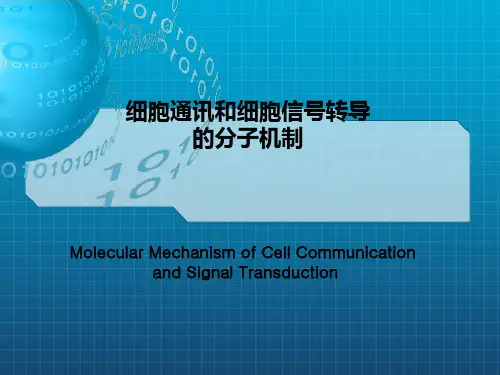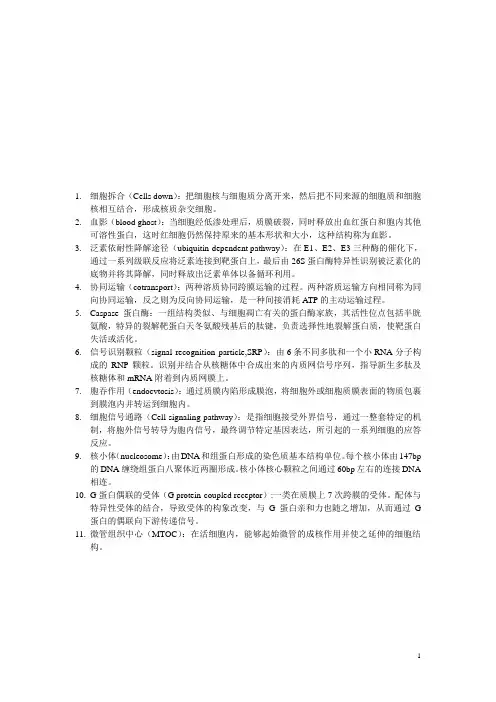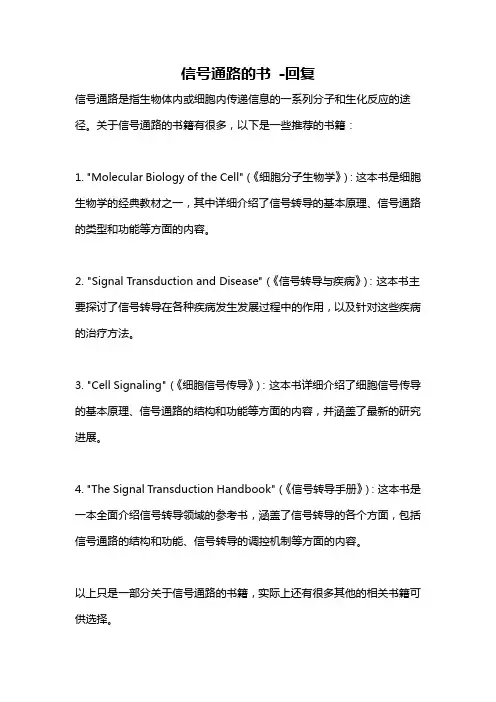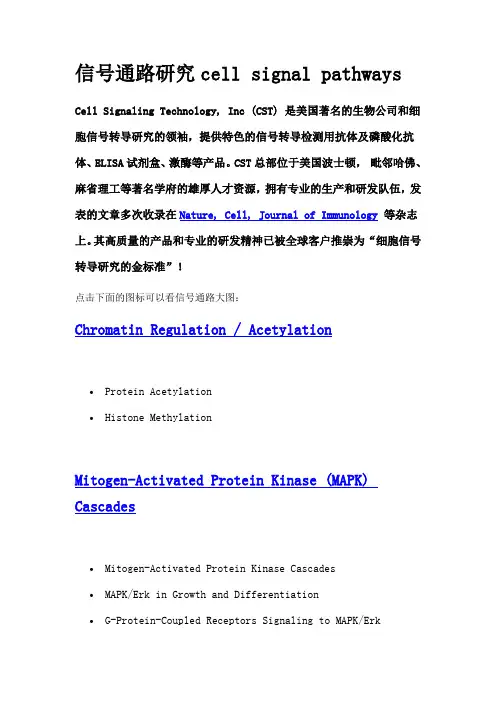细胞信号通路(Cell Signaling)
细胞信号转导通路

Chromatin/Epigenetics Resources
Overview of Chromatin / Epigenetics
Chromatin regulation refers to the events affecting chromatin structure and therefore, transcriptional control of gene expression patterns. Epigenetics, specifically, refers to the heritable modifications which result in altered gene expression and are not known to be encoded in DNA. The nucleosome, made up of four histone proteins (H2A, H2B, H3, and H4), is the primary building block of chromatin. Originally thought to function as a static scaffold for DNA packaging, histones have more recently been shown to be dynamic proteins, undergoing multiple types of post-translational modifications (PTMs) and interacting with regulatory proteins to control gene expression. Protein acetylation plays a crucial role in regulating chromatin structure and transcriptional activity. Histone hyperacetylation by histone acetyltransferases (HATs) is associated with transcriptional activation, whereas histone deacetylation by histone deacetylases (HDACs) is associated with transcriptional repression. Hyperacetylation can directly affect chromatin structure by neutralizing the positive charge on histone tails and disrupting nucleosome-nucleosome and nucleosomeDNA interactions. In addition, acetylation creates binding sites for bromodomain-containing chromatin regulatory proteins (histone modification readers). Unlike acetylation, methylation does not alter the charge of arginine and lysine residues and is unlikely to directly modulate nucleosomal interactions required for chromatin folding. Methylated arginine and lysine residues are major determinants for formation of active and inactive regions of the genome. Methylation facilitates binding of chromatin regulatory proteins/histone modification readers that contain various methyl-lysine or methyl-arginine binding domains (PHD, chromo, WD40, Tudor, MBT, Ankyrin repeats, PWWP domains). Recruitment of co-activator and co-repressor proteins is dependent on the specific lysine residue that is modified. The modulation of chromatin structure is an essential component in the regulation of transcriptional activation and repression. One strategy by which chromatin structure can be modulated is through disruption of histone-DNA contacts by ATP-dependent chromatin remodelers, such as the NuRD, Polycomb, and SWI/SNF complexes, which have been shown to regulate gene activation/repression, cell growth, the cell cycle, and differentiation. Chromatin structure is also modulated through other PTMs such as phosphorylation of histone proteins, which affects association with DNA-interacting proteins and has been recently identified to play a role in coordinating other histone modifications. Furthermore, methylation of DNA at cytosine residues in mammalian cells affects chromatin folding and is a heritable, epigenetic modification that is critical for proper regulation of gene silencing, genomic imprinting, and development. Three families of mammalian DNA methyl-transferases have been identified, DNMT1/2/3, that play distinct roles in embryonic stem cells and adult somatic cells. In addition to the core histone proteins, a number of histone variants exist that confer different structural properties to nucleosomes and play a number of specific functions such as DNA repair, proper kinetochore assembly and chromosome segregation during mitosis, and regulation of transcription. Chromatin and epigenetic regulation is crucial for proper programming of the genome during development and under stress conditions, as the misregulation of gene expression can lead to diseased states such as cancer.
细胞通讯和细胞信号转导

名称
合成部位 化学特性
主要作用
肾上腺素 肾上腺 酪氨酸衍生物 提高血压、心率、增强代谢
皮质醇
肾上腺 类固醇
在大多数组织中影响蛋白、糖、脂肪的代谢
雌二醇
卵巢
类固醇
诱导和保持雌性副性征
胰高血糖素 胰α细胞 肽
胰岛素
胰β细胞 蛋白质
睾酮
睾丸
类固醇
在肝、脂肪细胞刺激葡萄糖合成、糖原断裂、 脂断裂
刺激肝细胞等葡萄糖吸收、蛋白质及脂的合 成
亚基与催化亚基分开,被
激活的催化亚基可使底物
cAMP激活蛋白激酶A
➢ 蛋白激酶A的细胞质功能和细胞核功能
PKA既可直接修 饰细胞质中的底物蛋白, 使之磷酸化后立即起作 用,也可以进入细胞核 作用于基因表达的调控 蛋白,启动基因的表达。
cAMP与蛋白激酶对细胞活性的影响
蛋白激酶A的细胞质功能:
糖原分解:在脊椎动物中,糖原的分解受一些激素的控制,如肾上 腺素和胰高血糖素中的任何一种激素同细胞膜受体结合,都会激活磷酸 化酶,使糖原分解成1-磷酸葡萄糖,然后进一步分解为6-磷酸葡萄糖、 葡萄糖后进入血液 。
PKC系统的信号转导
由于该系统中的第二信使是磷脂肌醇,故此这一系统又称为磷脂 肌醇信号途径(phosphatidylinositol signal pathway)。
在这一信号转导途径中,膜受体与其相应的第一信使分子结合后, 激活膜上的Gq蛋白(一种G蛋白),然后由Gq蛋白激活磷酸脂酶Cβ (phos pholipase Cβ, PLC), 将膜上的脂酰肌醇4,5-二磷酸(phosphatidylinos itol biphosphate, PIP2)分解为两个细胞内的第二信使:二酰甘油( dia cylglycerol, DAG)和1,4,5-三磷酸肌醇(IP3)。IP3动员细胞内钙库释放 Ca2+到细胞质中与钙调蛋白结合,随后参与一系列的反应;而DAG在 Ca2+的协同下激活蛋白激酶C,然后通过蛋白激酶C引起级联反应,进 行细胞的应答, 故此将该系统称为PKC系统,或称为IP3、DAG、Ca2+信 号通路。
交大细胞名词解释

1.细胞拆合(Cells down):把细胞核与细胞质分离开来,然后把不同来源的细胞质和细胞核相互结合,形成核质杂交细胞。
2.血影(blood ghost):当细胞经低渗处理后,质膜破裂,同时释放出血红蛋白和胞内其他可溶性蛋白,这时红细胞仍然保持原来的基本形状和大小,这种结构称为血影。
3.泛素依耐性降解途径(ubiquitin-dependent pathway):在E1、E2、E3三种酶的催化下,通过一系列级联反应将泛素连接到靶蛋白上,最后由26S蛋白酶特异性识别被泛素化的底物并将其降解,同时释放出泛素单体以备循环利用。
4.协同运输(cotransport):两种溶质协同跨膜运输的过程。
两种溶质运输方向相同称为同向协同运输,反之则为反向协同运输,是一种间接消耗ATP的主动运输过程。
5.Caspase蛋白酶:一组结构类似、与细胞凋亡有关的蛋白酶家族,其活性位点包括半胱氨酸,特异的裂解靶蛋白天冬氨酸残基后的肽键,负责选择性地裂解蛋白质,使靶蛋白失活或活化。
6.信号识别颗粒(signal recognition particle,SRP):由6条不同多肽和一个小RNA分子构成的RNP颗粒。
识别并结合从核糖体中合成出来的内质网信号序列,指导新生多肽及核糖体和mRNA附着到内质网膜上。
7.胞吞作用(endocvtosis):通过质膜内陷形成膜泡,将细胞外或细胞质膜表面的物质包裹到膜泡内并转运到细胞内。
8.细胞信号通路(Cell signaling pathway):是指细胞接受外界信号,通过一整套特定的机制,将胞外信号转导为胞内信号,最终调节特定基因表达,所引起的一系列细胞的应答反应。
9.核小体(nucleosome):由DNA和组蛋白形成的染色质基本结构单位。
每个核小体由147bp的DNA缠绕组蛋白八聚体近两圈形成。
核小体核心颗粒之间通过60bp左右的连接DNA 相连。
10.G蛋白偶联的受体(G protein-coupled receptor):一类在质膜上7次跨膜的受体。
信号通路的书 -回复

信号通路的书-回复
信号通路是指生物体内或细胞内传递信息的一系列分子和生化反应的途径。
关于信号通路的书籍有很多,以下是一些推荐的书籍:
1. "Molecular Biology of the Cell"(《细胞分子生物学》):这本书是细胞生物学的经典教材之一,其中详细介绍了信号转导的基本原理、信号通路的类型和功能等方面的内容。
2. "Signal Transduction and Disease"(《信号转导与疾病》):这本书主要探讨了信号转导在各种疾病发生发展过程中的作用,以及针对这些疾病的治疗方法。
3. "Cell Signaling"(《细胞信号传导》):这本书详细介绍了细胞信号传导的基本原理、信号通路的结构和功能等方面的内容,并涵盖了最新的研究进展。
4. "The Signal Transduction Handbook"(《信号转导手册》):这本书是一本全面介绍信号转导领域的参考书,涵盖了信号转导的各个方面,包括信号通路的结构和功能、信号转导的调控机制等方面的内容。
以上只是一部分关于信号通路的书籍,实际上还有很多其他的相关书籍可供选择。
信号通路研究cell signal pathways

信号通路研究cell signal pathways Cell Signaling Technology, Inc (CST) 是美国著名的生物公司和细胞信号转导研究的领袖,提供特色的信号转导检测用抗体及磷酸化抗体、ELISA试剂盒、激酶等产品。
CST总部位于美国波士顿,毗邻哈佛、麻省理工等著名学府的雄厚人才资源,拥有专业的生产和研发队伍,发表的文章多次收录在Nature, Cell, Journal of Immunology等杂志上。
其高质量的产品和专业的研发精神已被全球客户推崇为“细胞信号转导研究的金标准”!点击下面的图标可以看信号通路大图:Chromatin Regulation / Acetylation∙Protein Acetylation∙Histone MethylationMitogen-Activated Protein Kinase (MAPK) Cascades∙Mitogen-Activated Protein Kinase Cascades∙MAPK/Erk in Growth and Differentiation∙G-Protein-Coupled Receptors Signaling to MAPK/Erk∙SAPK/JNK Signaling Cascades∙p38 MAPK Signaling Pathways Apoptosis / Autophagy∙Overview: Regulation of Apoptosis∙Inhibition of Apoptosis∙Death Receptor Signaling∙Mitochondrial Control of Apoptosis∙Autophagy SignalingPI3K / Akt Signaling Translational Control∙Regulation of eIF4E and p70 S6 Kinase ∙Regulation of eIF2∙mTor SignalingCa, cAMP & Lipid Signaling∙Protein Kinase C Signaling∙Phospholipase SignalingCell Cycle and Checkpoint Control∙G1/S Checkpoint∙G2M/DNA Damage CheckpointDNA DamageJak/Stat Pathway∙IL-6 Receptor SignalingNF-κB Signaling∙NF-κB Signaling∙Toll-Like Receptor SignalingTGF-β SignalingNeuroscience∙Amyloid Plaque and Neurofibrillary Tangle Formation in Alzheimer's Disease∙Dopamine Signaling in Parkinson's Disease Lymphocyte Signaling∙ B Cell Receptor Signaling∙T Cell Receptor SignalingTyrosine Kinase/ Adaptors∙Receptor & Cytoplasmic Tyrosine Kinases∙ErbB / HER Signaling∙Adaptor ProteinsAngiogenesisVesicle TraffickingCytoskeletal Signaling∙Regulation of Microtubule Dynamics∙Regulation of Actin DynamicsAdhesion∙Adherens Junction DynamicsEmbryonic Stem Cell and Lineage MarkersGlucose Metabolism∙Insulin Receptor Signaling∙AMPK SignalingWnt / Hedgehog / Notch∙Wnt / β-Catenin Signaling∙Hedgehog Signaling in Vertebrates∙Notch SignalingNuclear Receptor更多产品信息请联系:广州聚研生物科技有限公司电话:86-20-87322722/ 87328692传真:86-20-87328692网址:/地址:广州市中山一路51号拓业大厦506室(510600)E-mail:info@。
细胞的4类8种信号通路

细胞的4类8种信号通路
细胞的信号通路主要包括以下四种类型:
1. GPCR-cAMP-PKA 和 RTK-Ras-MAPK 信号通路:通过活化受体导致胞质蛋白激酶的活化,活化的胞质蛋白激酶转位到核内并磷酸化特异的核内转录因子,进而调控基因转录。
2. TGF-β-smad和JAK-STAT信号通路:通过配体与受体结合激活受体本身或偶联激酶的活性,然后直接或间接导致胞质内特殊转录因子的活化,进而影响核内基因的表达。
3. Wnt受体和Hedgehog受体介导的信号通路:通过配体与受体结合引发胞质内多蛋白复合物去装配,从而释放转录因子,转录因子再转位到核内调控基因表达。
4. NF-κB和Notch信号通路:通过抑制物或受体本身的蛋白切割作用,释放活化的转录因子,转录因子再转位到核内调控基因表达。
细胞信号转导与疾病之间的联系
细胞信号转导与疾病之间的联系细胞信号转导(cell signaling)是一种生物学现象,描述的是细胞间或细胞内部分子之间通过化学信号进行交流的过程。
在任何单个生物体内,至少存在数万亿个细胞。
这些细胞需要相互通信才能通过协同作用完成复杂的生理过程。
信号分子(signal molecule)扮演了细胞通信的角色。
细胞通过识别、接受和响应信号分子的变化来适应环境,维持稳态,或者对外界刺激做出反应。
通常意义下,信号通路(signaling pathway)指的是一个细胞通过一组互相关联的信号分子、受体、信号转导链、效应分子完成具体生理功能的过程。
细胞信号转导通常可以被分成三类不同的方式:通过细胞间信号(paracrine signaling)、通过接触性信号(juxtacrine signaling)和通过范围为整个体的信号(endocrine signaling)。
在绝大多数生理过程中,信号通路通常是细胞内信号传递。
这是指通过细胞膜的受体感受这种信号,并将信息传递到细胞内部。
这个过程可以通过多种信号转导机制实现,包括蛋白质磷酸化、G蛋白偶联受体根据活性变化和DNA转录文件的表达变化等。
细胞信号转导异常与病理有关系。
在某些病理过程中,细胞出现了信号传递功能障碍或异常激活。
而有些疾病状况则是基于有些细胞进行的过度或是不恰当的信号传递,导致了细胞和肿瘤疾病的发展。
一些细胞信号转导紊乱与癌症罹患的高风险性相关联。
例如,异常信号转导可能导致细胞增殖、转移和耐药之类的异常。
这是因为这些信号转导机制可以导致细胞外层上的信号感受器和内层细胞正常功能中断。
细胞增殖经过迅速增加,这个机理造就了癌症的诸多网状成分。
一些疾病,如罹患语言运动障碍症候群或是糖尿病等慢性病,都和细胞信号转导有关联。
此外,一些细胞信号转导机制还和神经退化性疾病相关。
例如,阿尔茨海默病就和β淀粉样蛋白降解异常有关系。
β淀粉样蛋白具有一定毒性,可以导致神经细胞的丧失。
细胞生物学[第八章细胞信号转导]课程预习
第八章细胞信号转导一、概述(一)细胞通讯细胞通讯(cell communication)是指一个细胞发出的信息通过介质传递到另一个细胞产生相应的反应。
1.细胞通讯的方式(1)细胞通过分泌化学信号进行细胞间相互通讯。
这是多细胞生物包括动物和植物最普遍采用的通讯方式。
(2)细胞间接触性依赖的通讯(contact-dependent signaling)。
细胞间直接接触,通过与质膜组合的信号分子影响其他细胞。
(3)细胞问形成间隙连接使细胞质相互沟通,通过交换小分子来实现代谢偶联或电偶联。
2.细胞分泌化学信号的作用方式(1)内分泌(endocrine)。
由内分泌细胞分泌信号分子(激素)到血液中,通过血液循环运送到体内各个部位,作用于靶细胞。
(2)旁分泌(paracrine)。
细胞通过分泌局部化学介质到细胞外液中,经过局部扩散作用于邻近靶细胞。
(3)自分泌(autocrine)。
细胞对自身分泌的物质产生反应。
(4)通过化学突触传递神经信号(neuronal signaling)。
当神经元细胞在接受环境或其他神经细胞的刺激后,神经信号通过动作电位的形式沿轴突以高达100m/s的速度传至末梢,刺激突触前突起终末分泌化学信号(神经递质或神经肽),快速扩散作用于突触后细胞,影响突触后膜,实现电信号一化学信号一电信号转换和传导。
细胞识别(cell recognition)是指细胞通过其表面受体与胞外信号物质分子(配体)选择性相互作用,从而导致胞内一系列生理生化变化,最终表现为细胞整体的生物学效应的过程。
可见,细胞识别是细胞通讯的一个重要环节。
细胞信号通路(signaling pathway):细胞接受外界信号,通过一整套特定的机制,将胞外信号转导为胞内信号,最终调节特定基因的表达,引起细胞的应答反应,这是细胞信号系统的主线,这种反应系列称之为细胞信号通路。
(二)信号分子与受体1.信号分子细胞的信号分子(signal molecule)可根据其溶解性分为亲脂性和亲水性两类:(1)亲脂性信号分子主要代表是甾类激素和甲状腺素。
细胞信号转导的意义及其应用
细胞信号转导的意义及其应用细胞信号转导(cellular signaling pathway)是细胞内外发生的能够调控细胞行为的过程。
它涉及到复杂的分子互作、反应途径和调节机制,其中包括了分子信号的接收、传递和响应。
这个过程在细胞内外的正常空间环境下,或者根据特定的利益集合,在异常环境中发挥着先导作用。
因此,细胞信号转导的研究成为了许多学科的重要研究方向。
本文主要介绍细胞信号转导的意义、应用及其相关研究进展。
一、细胞信号转导的意义细胞信号传导通常指细胞之间的通讯和信息交流过程。
它是维持细胞的功能和生存所必需的基础。
细胞信号传导被广泛认为是细胞生物学中最重要的研究领域之一,其研究对生命科学的发展和应用有很大的贡献。
1. 主要控制生物过程生物体是由不同种类的细胞组成的,每种细胞都具有自己的特定功能和生存条件。
细胞信号转导是生物复杂多样的细胞之间进行通讯和交流的核心机制。
它通过调节响应细胞内、外环境变化的反应,使细胞在不同的状态下保持自身特定的行为。
细胞间的信息传递和互相作用,控制了许多重要的生命过程,如细胞增殖、分化,以及癌症、心血管等疾病的发生等。
2. 可以启发新的治疗策略由于细胞信号转导是控制生物过程的关键因素之一,因此研究它已成为许多领域的重要课题。
正常情况下,它是为了维持生物体的正常生理功能而存在。
但当信号转导通路异常时,它可能会导致各种疾病的发展。
研究细胞信号转导可以识别与疾病相关的信号,为疾病的治疗提供新的思路和方法。
对于癌症来说,深入研究信号转导通路的分子机制,找到抑制癌细胞的关键信号分子,可以为靶向癌症治疗提供新途径。
二、细胞信号转导的应用随着细胞信号转导的研究深入,人们已经可以将相关知识用于医学诊断、预防、治疗和药物开发等方面。
以下是细胞信号转导的主要应用。
1. 新药研发药物研发是细胞信号转导的一个重要应用领域。
利用细胞信号通路的相关机制和调节途径,可以构建更加精准的药物靶点,提高药物疗效。
细胞信号通路在肿瘤发生发展中的作用
细胞信号通路在肿瘤发生发展中的作用中文摘要:细胞信号通路在生物体中发挥着重要的作用。
肿瘤的发生和发展与细胞信号通路的异常有着紧密关联。
细胞信号通路可分为多个分支,其中包括WNT、NOTCH、JAK-STAT、PI3K-Akt和RAS-MAPK等分支。
这些信号通路在肿瘤发生和发展中起着不同的作用,可调控细胞的增殖、分化、凋亡和代谢。
此外,一些调节蛋白、激酶和转录因子也参与了肿瘤的发生和发展。
因此,细胞信号通路可能成为肿瘤治疗的重要靶点。
关键词:细胞信号通路;肿瘤;分支;增殖;凋亡英文摘要:Cell signaling pathways play an important role in the organism.The occurrence and development of tumors are closely related tothe abnormality of cell signaling pathways. Cell signaling pathways can be divided into many branches, including WNT, NOTCH, JAK-STAT, PI3K-Akt, and RAS-MAPK. These signaling pathways play different roles in the occurrence and development of tumors, and can regulate the proliferation, differentiation, apoptosis, and metabolism of cells. In addition, some regulatory proteins, kinases, and transcription factors are also involved in the occurrence and development of tumors. Therefore, cell signaling pathways may become an important target for tumor therapy.Keywords: cell signaling pathways; tumor; branch; proliferation; apoptosis小标题:一、细胞信号通路二、肿瘤的异常分子通路三、肿瘤的治疗靶点——细胞信号通路正文:一、细胞信号通路细胞信号通路是一种涉及细胞内和细胞间的信息传递系统。
- 1、下载文档前请自行甄别文档内容的完整性,平台不提供额外的编辑、内容补充、找答案等附加服务。
- 2、"仅部分预览"的文档,不可在线预览部分如存在完整性等问题,可反馈申请退款(可完整预览的文档不适用该条件!)。
- 3、如文档侵犯您的权益,请联系客服反馈,我们会尽快为您处理(人工客服工作时间:9:00-18:30)。
Mineralocorticoids
– Aldosterone
Forms of signaling molecules
• Neurotransmitters
Multiple levels of cell signaling
Endocrine signals target distant cells.
Endocrine cells produce hormones that travel through the blood to reach all parts of the body.
Pararine signals target cells in the vicinity of the emitting cell.
Signaling Receptor
• A cell targeted by a particular chemical signal has a receptor protein that recognizes the signal molecule.
• The response of a particular cell to a signal depends on the type of proteins it contains.
• Errors in cellular information processing are responsible for diseases such as cancer, autoimmunity, and diabetes.
• By understanding cell signalling, diseases may be treated effectively and, theoretically, artificial tissues may be created.
Responding to the outside world
Extracellular signal → receptor → transducer → effector
Forms of signaling molecules
Gasses
• • • • • • • NO CO Testosterone Estradiol Progesterone Glucocorticoids
Cell Receptors
Cell surface receptors
• Cell surface receptors (membrane receptors, transmembrane receptors) are specialized integral membrane proteins that take part in communication between the cell and the outside world. •
• G protein-coupled receptors are involved in many diseases, and are also the target of around half of all modern medicinal drugs.
• There are two principal signal transduction pathways involving the G-protein coupled receptors: cAMP signal pathway and Phosphatidylinositol signal pathway.
• For example, after the epidermal growth factor (EGF) receptor binds with its ligand EGF, two receptors dimerize and then undergo phosphorylation of the tyrosine residues in the enzyme portion of each receptor molecule, which will activate the tyrosine protein kinase and catalyze further intracellular reactions.
An example of this are immune cells.
Juxtacrine signals target adjacent (touching) cells. These signals are transmitted along cell membranes via protein or lipid components integral to the membrane and are capable of affecting either the emitting cell or cells immediately adjacent.
• Signal transduction occurs when an extracellular signaling molecule activates a specific receptor located on the cell surface or inside the cell.
• In turn, this receptor triggers a biochemical chain of events inside the cell, creating a response. Depending on the cell, the response alters the cell's metabolism, shape, gene expression, or ability to divide.
• Enzyme-linked receptors are either enzymes themselves, or are directly associated with the enzymes that they activate. • These are usually single-pass transmembrane receptors, with the enzymatic portion of the receptor being intracellular. The majority of enzyme-linked receptors are protein kinases, or associate with protein kinases.
G-protein-coupled receptors
G protein-coupled receptors are integral membrane proteins that possess seven membrane-spanning domains or transmembrane helices.
• G protein-coupled receptors comprise a large family transmembrane receptors. • They are found only in eukaryotes. • The ligands that bind and activate these receptors include light-sensitive compounds, odors, pheromones, hormones, and neurotransmitters, and vary in size from small molecules to peptides to large proteins.
Cell surface receptors
• Extracellular signaling molecules (usually hormones, neurotransmitters, cytokines, growth factors or cell recognition molecules) attach to the receptor, triggering changes in the function of the cell.
Neurotransmitters represent an example.
Autocrine signals are produced by the target cell, are secreted, and effect the target cell itself via receptors. Sometimes autocrine cells can target cells close by if they are the same type of cell as the emitting cell.
• Receptor tyrosine kinases is the one kind with the largest population and most widely application. The majority of these molecules are receptors for growth factors and hormones like epidermal growth factor (EGF), platelet derived growth factor (PDGF), fibroblast growth factor (FGF), hepatocyte growth factor (HGF), insulin, nerve growth factor (NGF) etc. • Most of these receptors will dimerize after binding with their ligands in order to activate further signal transductions.
• Calcium is used in many processes including muscle contraction, neurotransmitter release from nerve endings, and cell migration.
